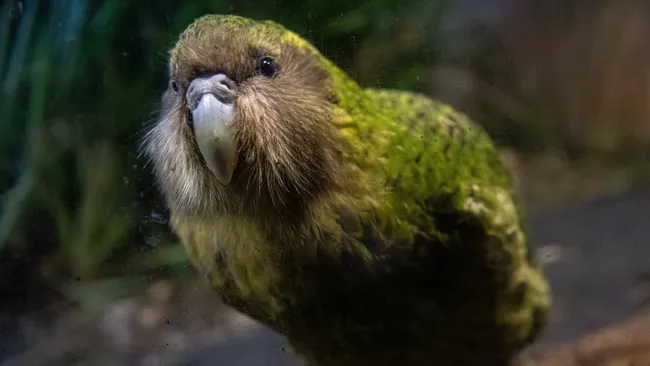This flightless nocturnal parrot is only found in New Zealand.
New Zealand’s Kākāpō: The Charming, Critically Endangered ‘Night Parrot’
The first thing you’ll notice about the kākāpō — a large, flightless parrot found only in New Zealand — is how adorably rotund it is.
With round heads, owl-like faces, stout legs, and stocky bodies, these birds are unmistakable. In fact, kākāpō are the largest parrots alive today. Males can grow up to 25 inches (64 cm) long and weigh as much as 9 pounds (4 kg). They’re also among the longest-lived birds in the world, with some individuals estimated to live up to 90 years.
The name kākāpō means “night parrot” in Māori, a reference to the bird’s nocturnal habits. Though they cannot fly, kākāpō are strong walkers and skilled climbers, using their short wings for balance as they clamber through New Zealand’s forests. When threatened, they rely on camouflage rather than escape — freezing in place and blending into the forest floor with their mossy green plumage.
A Bird with a Scent and a Song
Unusually for birds, male kākāpō emit a distinct, musky odor described by scientists as “sweet and vegetative.” This scent may play a role in attracting mates, as does their curious and loud courtship ritual.
Kākāpō are the only parrot species known to practice lekking — a mating system where males gather in designated display areas to compete for female attention. Each male digs a shallow, bowl-like depression in the ground and performs a bizarre audio display, booming like a tuba for hours on end. These low-frequency “booms” can travel up to five kilometers through the forest and are punctuated by sharp, metallic “ching” calls. Males may perform these sounds nightly for months at a time.
In the absence of female interest, kākāpō have been known to misdirect their romantic energy. In 1990, author Douglas Adams famously recounted an encounter with an overenthusiastic kākāpō in Last Chance to See, writing:
“When one of the rangers who was working in an area where kākāpōs were booming happened to leave his hat on the ground, he came back later to find a kākāpō attempting to ravish it.”

This behavior wasn’t isolated. One particularly amorous bird named Sirocco became notorious for trying to mate with human heads. Researchers even developed a special “ejaculation helmet” to collect his sperm for use in artificial insemination — part of a broader conservation effort to help boost the fragile kākāpō population.
A Precarious Path to Survival
Kākāpō breed only once every two to four years, coinciding with mast years — when native rimu trees produce an abundance of fruit rich in calcium and vitamin D, vital for healthy egg and chick development.
For tens of millions of years, kākāpō thrived throughout New Zealand, safe from mammalian predators. But the arrival of Polynesian settlers around 700 years ago marked the beginning of their decline. The situation worsened dramatically with European colonization in the 1800s, which brought large-scale deforestation and invasive predators like rats, cats, and stoats.
By the mid-20th century, the kākāpō was on the verge of extinction. But in the 1970s, a small breeding population — just over 200 birds — was discovered. Conservationists quickly moved to protect the remaining kākāpō, relocating them to predator-free islands and launching intensive monitoring, genetic research, and breeding programs.
Today, there are about 242 kākāpō alive — all living on just three predator-free islands. While the population is growing, the species remains critically endangered, with a high risk of extinction.
Hope on the Horizon
Thanks to decades of dedicated work, the kākāpō is one of the world’s most closely monitored and scientifically managed bird species. Each individual is named, tagged, and tracked. From artificial insemination to genetic pairing programs, conservationists continue to push the limits of what’s possible to ensure the survival of this remarkable parrot.
Still, the kākāpō’s future depends on continued support, funding, and vigilance. With global biodiversity under increasing threat, the story of the kākāpō is both a cautionary tale and a beacon of hope — a reminder that with effort, even species once on the brink can find their way back.
